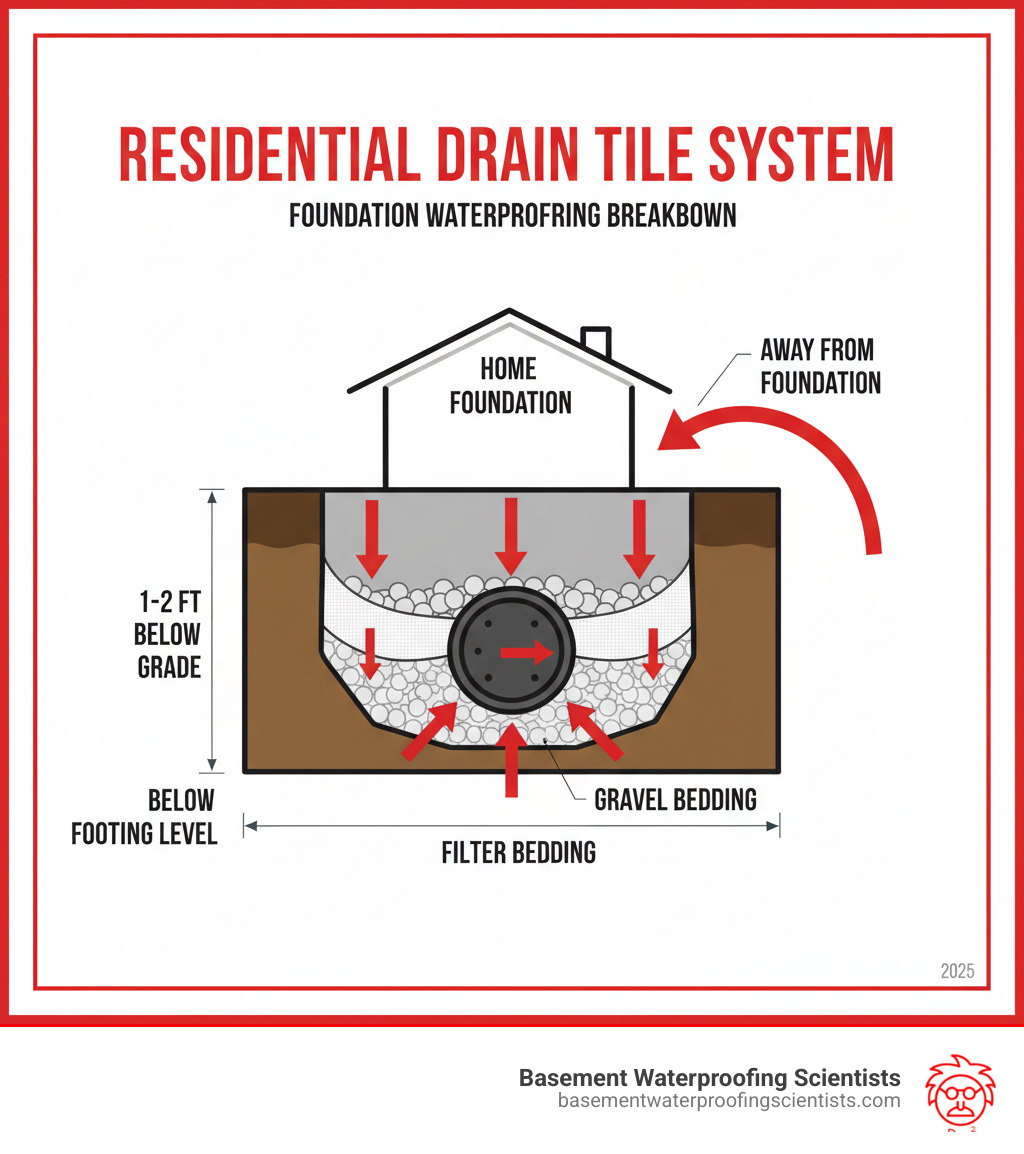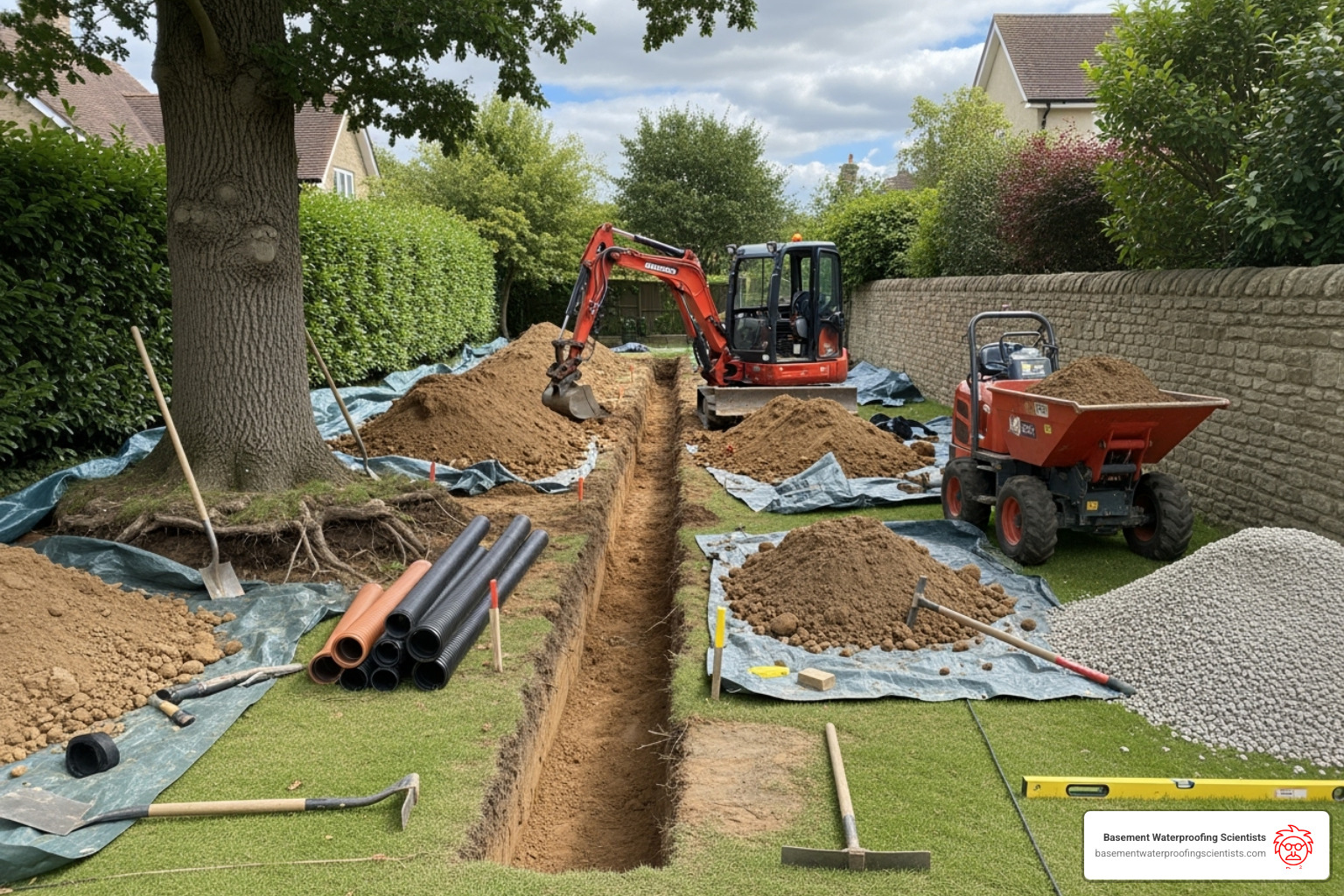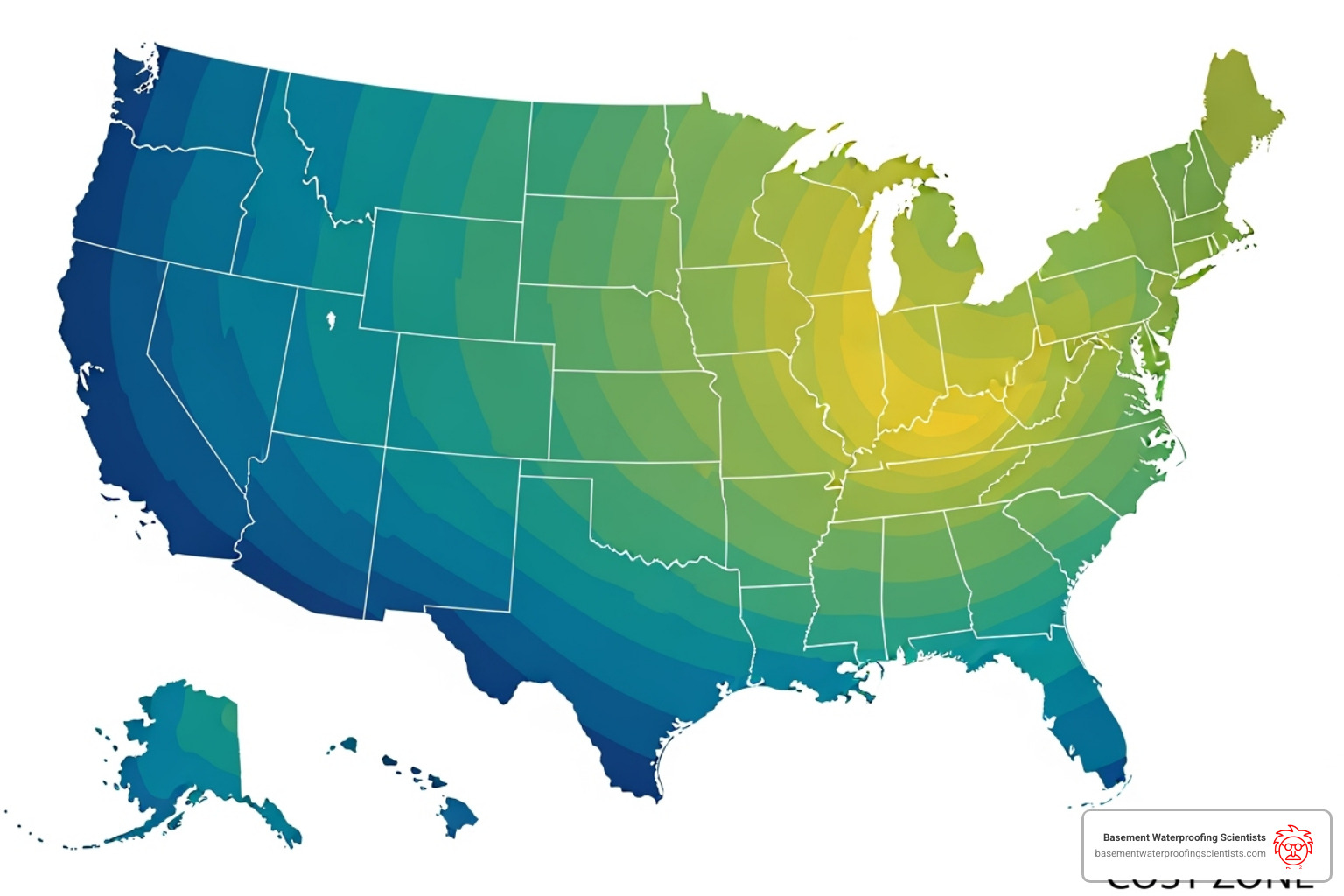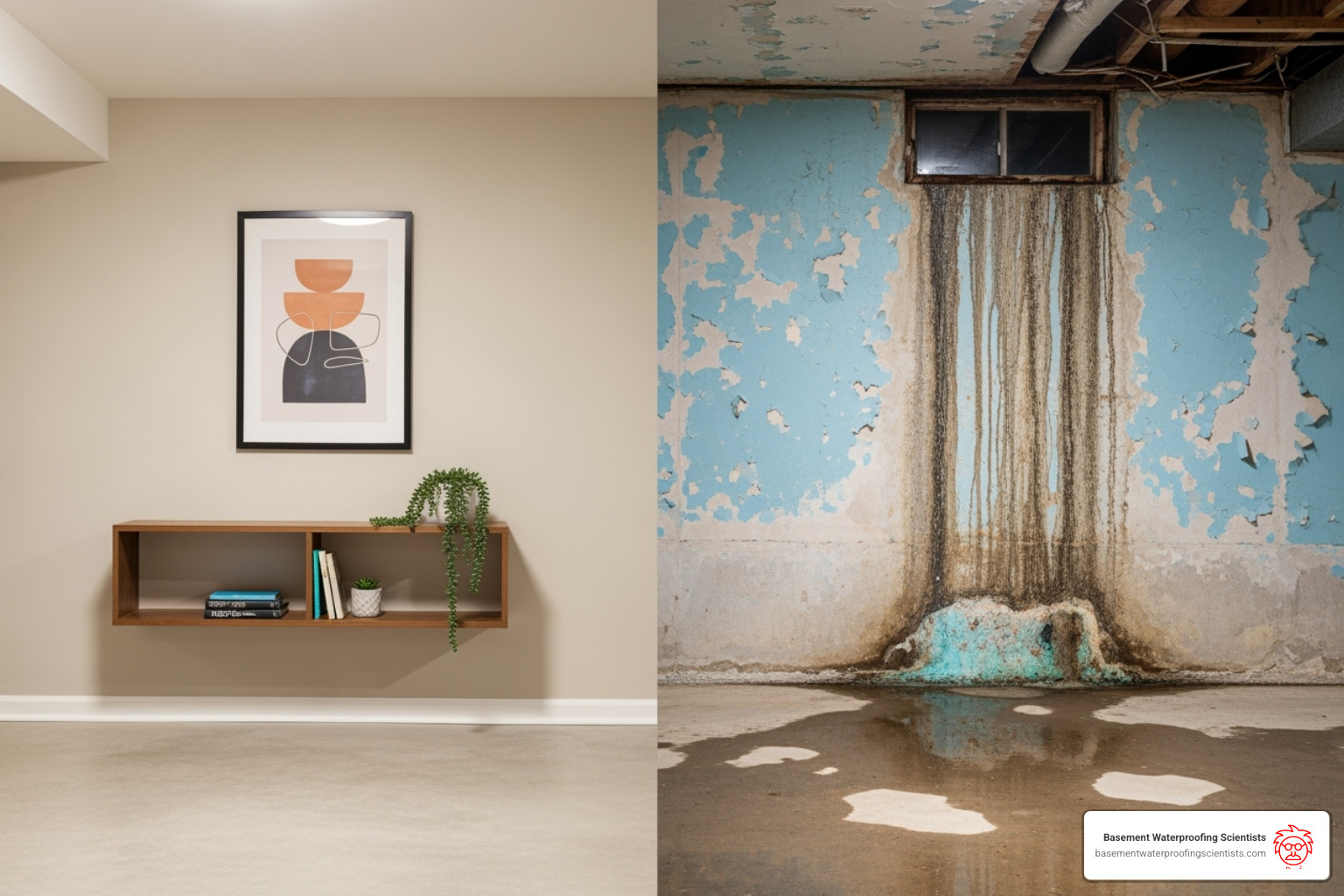Understanding Field Tile Pricing for Your Home’s Protection
Field tile price per foot varies significantly based on your specific drainage needs, but most homeowners can expect to pay between $15-30 per linear foot for professional installation. Here’s what you need to know:
Quick Cost Overview:
- Basic residential drain tile: $15-20 per foot
- Complex installations: $25-30+ per foot
- Total project costs: $4,000-8,000 for most homes
- Agricultural field tile: $0.30-2.00 per foot (different application)
When homeowners search for field tile costs, they’re usually dealing with water problems around their foundation – not agricultural drainage. Residential “field tile” refers to perforated drainage pipes installed around your home’s perimeter to collect groundwater and direct it away from your basement.
This system differs completely from agricultural field tile, which farmers use for crop drainage at much lower per-foot costs. For your home, you’re investing in a foundation protection system that prevents costly water damage and creates a dry, usable basement space.
As Darin Garvey from Basement Waterproofing Scientists, I’ve helped hundreds of homeowners understand field tile price per foot calculations over my 30+ years in foundation waterproofing. My team specializes in creating customized drainage solutions that address each home’s unique water challenges while providing transparent, fair pricing.

Understanding the Average Field Tile Price Per Foot
When homeowners start researching field tile price per foot, they’re usually dealing with water seeping into their basement – and rightfully concerned about the cost to fix it permanently. Let me clear up some confusion right away: residential “field tile” (also called weeping tile) has completely different pricing than agricultural field tile you might see discussed in farming forums.
For your home’s foundation drainage, expect to pay $15-30 per linear foot for professional installation. This weeping tile cost covers everything needed for a proper system: excavation around your foundation, the perforated drainage pipe, gravel backfill, and skilled labor to ensure proper slope and connection to your drainage outlet.
Per linear foot pricing makes sense because every home is different. A small ranch might need 120 linear feet, while a larger colonial could require 180+ feet of drainage tile around the full perimeter. With most systems falling in that range, total project costs typically run between $4,000 and $8,000 – which aligns perfectly with our average basement waterproofing projects.
Here’s where it gets confusing for homeowners: agricultural vs residential costs are vastly different. Farm field tile installations you’ll see discussed on sites like Red Power Magazine’s drainage tile cost forum might mention costs of $0.30-$2.00 per foot. Those agricultural systems use specialized plows to install miles of tile quickly across open fields – completely different from the precision excavation required around your home’s foundation.
Agricultural field tile serves a different purpose too. Farmers drain cropland to improve growing conditions, while your residential system protects your home’s foundation and creates a permanently dry basement. The materials, installation methods, and quality standards are worlds apart.
When you’re dealing with basement water problems in areas like Philadelphia, Reading, or anywhere in Pennsylvania, New Jersey, and Delaware, you need a system built for your home’s specific challenges. That means proper excavation depth, quality materials, and installation expertise that ensures your basement stays dry for decades.
For detailed information specifically about residential installations, check out our comprehensive guide on Drain Tile Installation Cost – it focuses on what actually matters for protecting your home, not draining farm fields.
Key Factors That Influence Installation Costs

No two homes are alike, and neither are their drainage needs. While the average field tile price per foot gives you a starting point, the actual cost for your project depends on several key factors that we carefully evaluate during our initial inspection. These cost variables can significantly impact your final investment, ranging from simple installations to more complex projects that require specialized solutions.
Understanding these factors helps you make informed decisions and sets realistic expectations for your drainage system installation. Let’s break down the main elements that influence project complexity and how your specific site conditions affect pricing.
Project Scope and System Type
The biggest decision you’ll face is choosing between interior vs. exterior drains, and this choice dramatically affects both cost and effectiveness. Exterior systems require extensive excavation around your home’s foundation, often disrupting landscaping, sidewalks, and driveways. These systems can cost between $15,000 to $20,000 due to the massive amount of digging and restoration work involved.
Here’s the catch: exterior systems are notorious for clogging. Dirt, roots, and debris constantly threaten these systems, making them what many experts call “a recipe for failure.” After spending all that money and dealing with the disruption, you might find yourself back at square one in a few years.
Interior drainage systems offer a smarter approach. Installed beneath your basement floor along the perimeter, these systems intercept water before it becomes a problem in your living space. They’re more reliable, less disruptive, and often more cost-effective in the long run.
Your choice between a full perimeter system and targeted drainage also affects the field tile price per foot calculation. A complete perimeter system provides comprehensive protection for your entire basement, while targeted solutions address specific problem areas. While targeted approaches might seem more budget-friendly initially, they often lead to future issues when water finds new ways into your basement.
System complexity varies based on your home’s unique challenges. Some installations require multiple discharge points, integration with existing plumbing, or specialized components like battery backup systems. Each additional element adds to the overall project scope. For detailed information about interior solutions, check out our guide on French Drain in Basement.
Excavation and Labor
The physical work of installing your drainage system represents a major portion of your investment, and several factors influence these excavation and labor costs. Excavation depth plays a crucial role – deeper installations require more time, specialized equipment, and careful attention to safety protocols.
Soil type can make or break a project timeline. Sandy, loose soil excavates quickly and easily, keeping labor costs down. Dense clay, rocky conditions, or expansive soils? That’s a different story entirely. I’ve seen projects where we thought we’d finish in a day, only to spend three days battling stubborn bedrock that seemed determined to protect every inch of ground.
Site accessibility significantly impacts your costs. Homes with wide-open access for our equipment keep things moving efficiently. But when we encounter tight spaces, mature landscaping, or obstacles like decks and sheds, everything slows down. Hand-digging in confined areas naturally increases labor hours and costs.
Don’t forget about landscaping restoration after we complete the work. While our team takes great care to minimize disruption, some restoration work is often necessary to return your property to its original condition.
Labor rates vary by region, but skilled waterproofing professionals command fair wages for their expertise. In many markets, excavation runs $10-$25 per linear foot, with skilled installation labor ranging from $75-$120 per hour. Our experienced team ensures every aspect of your installation meets the highest standards, preventing costly callbacks and future problems. For more insights into construction labor costs, resources like Labor Wages and Costs: Building a Unit-Price System provide helpful context.
Materials and Components
Quality materials and components directly impact both your field tile price per foot and the long-term performance of your drainage system. The perforated pipe itself comes in various diameters and materials, from rigid PVC to flexible corrugated options. Larger diameter pipes handle more water volume but cost more upfront – though they’re often worth the investment for long-term reliability.
Gravel backfill provides essential drainage and filtration around your pipe system. The volume required and local gravel costs, including delivery, contribute significantly to material expenses. We use specific gravel grades that maximize drainage while preventing system clogging.
Filter fabric wraps around the pipe and gravel assembly, preventing soil particles from infiltrating your drainage system. While this represents a smaller cost component, it’s absolutely critical for long-term system performance.
Beyond these basics, many residential systems require additional components that affect overall pricing. Sump pump systems become necessary when gravity drainage isn’t feasible, actively removing collected water from your basement. Catch basins collect surface water and direct it into your drainage network, while cleanouts provide strategic access points for future maintenance and inspection.
Discharge lines carry water safely away from your foundation to appropriate discharge points. Each component adds material costs and installation complexity, influencing your total field tile price per foot calculation.
The key is selecting components that match your specific needs without over-engineering the system. Our experience helps identify the right balance between performance and cost-effectiveness. For systems involving pumps and specialized drainage components, explore our resources on Sump Pump French Drain and Basement Drains.
Cost Breakdown: Materials, Labor, and Regional Differences

When you get that first estimate for your basement drainage system, it might feel like you’re looking at hieroglyphics. Where exactly is your money going? Understanding the price components behind your field tile price per foot helps you make sense of the investment and see why costs can vary so much from one home to another.
The truth is, geographic variance plays a bigger role than most homeowners realize. A drainage system that costs $5,000 in rural Pennsylvania might run $7,500 in downtown Philadelphia – and that’s not because city contractors are trying to gouge you. It’s simply the reality of different labor markets, material costs, and local requirements.
Typical Cost Breakdown: Materials vs. Labor
Here’s something that surprises many homeowners: labor costs eat up the biggest chunk of your drainage budget. When you think about it, this makes perfect sense. Installing a proper drainage system isn’t just about laying pipe in a hole – it requires skilled technicians who know exactly how to grade for proper water flow, where to place cleanouts, and how to integrate everything with your existing foundation.
| Cost Component | Percentage of Total Project Cost (Estimated) |
|---|---|
| Labor Costs | 50-60% |
| Material Costs | 20-30% |
| Equipment Rental | 10-15% |
| Permit Fees | 1-5% |
Labor costs cover everything from the initial excavation to the final cleanup. Our technicians bring decades of experience to each job, and that expertise shows in systems that work flawlessly for years. You’re not just paying for muscle – you’re investing in knowledge that prevents costly mistakes.
Material costs include the obvious stuff like perforated pipe and gravel, but also the details that matter long-term: high-quality filter fabric, proper fittings, and durable sump pump components when needed.
Equipment rental might seem like a small line item, but specialized excavators and trenchers are essential for efficient, precise installation. Hand-digging a basement perimeter would take weeks and cost far more in labor.
Permit fees are usually minimal but necessary. They ensure your drainage system meets local codes and won’t cause problems for you or your neighbors down the road.
These percentages shift depending on your specific situation. A straightforward installation with easy access will lean more heavily toward materials, while a complex job requiring extensive hand-digging might see labor costs climb even higher.
How Location Impacts the Field Tile Price Per Foot
Location affects your field tile price per foot in ways you might not expect. In our service areas – Philadelphia, Reading, Norristown, and throughout Pennsylvania, New Jersey, and Delaware – we see significant cost variations even within a single county.
Regional labor rates reflect local economic realities. Urban areas typically have higher wages across all skilled trades, and waterproofing is no exception. A crew working in Center City Philadelphia commands different rates than one working in rural Lancaster County, and both are fair for their respective markets.
Material availability creates another layer of cost variation. Homes near quarries benefit from lower gravel delivery costs, while properties in dense urban areas might pay premium rates for materials that are harder to transport and store.
Local regulations can add unexpected complexity too. Some municipalities require special discharge permits or have strict rules about where water can be directed. Others mandate specific excavation procedures or restoration requirements that affect the overall project scope.
For perspective, while agricultural drainage in places like Southern Minnesota might cost $700-800 per acre, residential waterproofing operates in a completely different universe. We’re not installing miles of tile across open fields – we’re creating precision-engineered systems that protect your home’s foundation and keep your basement permanently dry.
Understanding these regional factors helps explain why getting multiple local estimates is so important. The Occupational Employment and Wage Statistics from the Bureau of Labor Statistics can give you a broader view of how wages vary across different regions, though nothing beats talking with local contractors who understand your specific area’s challenges and requirements.
DIY vs. Professional Installation and Long-Term Value

When homeowners see field tile price per foot estimates ranging from $15-30, the temptation to tackle the project themselves is understandable. After all, how hard could it be to dig a trench and lay some pipe?
The reality is far more complex. What looks like a simple weekend project can quickly become a costly nightmare that actually increases your long-term expenses rather than reducing them.
The Pros and Cons of DIY Drain Tile Installation
The appeal of DIY cost savings is obvious – you’re only paying for materials and equipment rental instead of professional labor. For a typical home project, this might save you several thousand dollars upfront. But here’s where things get tricky.
Installing drain tile isn’t like building a deck or painting a room. It requires precise engineering knowledge about water flow, soil mechanics, and foundation dynamics. Get the slope wrong by even a fraction, and water sits in your pipes instead of flowing away. Miss an underground utility line, and you’re looking at emergency repair bills that dwarf any savings.
Safety hazards are real and serious. Trenches can collapse without warning, especially around foundations where soil has been disturbed. I’ve seen homeowners accidentally strike gas lines, water mains, and electrical conduits – each creating dangerous situations and expensive emergency repairs.
Perhaps most importantly, DIY installations come with no warranty. When we install a system, we back it with a lifetime guarantee because we know it will work. When your DIY system fails at 2 AM during a heavy rainstorm, you’re on your own for repairs and water damage cleanup.
Professional expertise means understanding why water behaves the way it does around your specific foundation. Our 30 years of experience has taught us that every home is different. We use specialized equipment to identify exactly where water is entering and design systems that address your unique challenges.
The long-term reliability of professional installation far outweighs the upfront savings of DIY. A properly installed system protects your home for decades, while a failed DIY attempt often requires complete reinstallation by professionals anyway.
The Economic Benefits of a Professional Drainage System
Think of professional drain tile installation as insurance for your most valuable asset. The return on investment goes far beyond avoiding wet basement headaches.
Preventing costly water damage is the most immediate benefit. Mold remediation alone can cost thousands of dollars, not to mention replacing damaged belongings, flooring, and drywall. We’ve seen homeowners spend $15,000 cleaning up water damage that could have been prevented with a $6,000 drainage system.
Protecting your foundation from hydrostatic pressure prevents structural problems that can cost tens of thousands to repair. When water-saturated soil pushes against foundation walls, cracks develop and worsen over time. A professional drainage system relieves this pressure before damage occurs.
Increasing property value happens in two ways. First, a dry basement becomes usable living space – potentially adding hundreds of square feet to your home’s functional area. Second, potential buyers won’t walk away from a house with obvious water problems. Real estate agents tell us that homes with professional waterproofing systems sell faster and for higher prices.
Improving indoor air quality throughout your entire home starts with eliminating basement moisture. Mold spores don’t stay in the basement – they circulate through your HVAC system, affecting your family’s health. A dry basement means cleaner air upstairs too.
Most importantly, you gain peace of mind knowing your home is protected. There’s real value in sleeping soundly during thunderstorms instead of worrying about basement flooding.
Our average basement waterproofing project costs between $4,000 and $8,000, but the value delivered far exceeds this investment. We use specialized equipment to identify leak sources, ensuring we fix problems correctly the first time with our lifetime guarantee.
For comprehensive information about professional drainage solutions, explore our guide to Basement Drainage Systems.
Frequently Asked Questions about Drain Tile Costs
Over my three decades in basement waterproofing, I’ve fielded countless questions from homeowners trying to understand field tile price per foot and what goes into their drainage investment. Let me share the most common concerns and give you straight answers based on real-world experience.
Are there government programs to help with drainage costs?
Here’s the reality: direct government assistance for residential drain tile is pretty rare, unlike agricultural programs that farmers can tap into. But don’t give up hope just yet!
Agricultural programs do exist in some areas – for instance, Ontario offers farmers up to 50% of their tile drainage costs through the Northern Ontario Heritage Fund Corp., maxing out at $500 per acre. While these don’t apply to your basement, they show that governments sometimes recognize proper drainage as a worthy investment.
Municipal rebates might be your best bet. Many cities offer stormwater management incentives for homeowners who help reduce runoff. Think rain gardens, disconnecting downspouts from storm sewers, or other green infrastructure projects. While not specifically for drain tile, these programs recognize that managing water around your home benefits everyone.
Your local program search should start with your city or county’s planning department. They’ll know about any available rebates, grants, or tax incentives for water management improvements. It’s worth a phone call – you might be pleasantly surprised!
How much do related components like sump pumps cost?
A complete basement drainage system often needs more than just perforated pipe. Sump pumps are frequently the unsung heroes of dry basements, especially when gravity alone can’t move water away from your foundation.
Sump pump cost varies widely based on what you need. The pump itself runs anywhere from $200 for basic models up to $1,000+ for high-capacity, feature-rich units. But remember – the pump is just part of the equation. Professional installation covers the pit excavation, plumbing connections, and electrical work.
Battery backup systems are what I call “insurance for your insurance.” When storms knock out power – exactly when you need your pump most – a backup system keeps running. These add another $300-$1,000+ to your investment, but trust me, they’re worth every penny when you’re not bailing water at 2 AM during a blackout.
Professional installation ensures everything works together seamlessly. You can buy a pump at the hardware store, but proper sizing, wiring, and integration with your drainage system prevents the heartbreak of system failure when you need it most.
For homes throughout our service areas – from Bensalem Township to Upper Darby Township and beyond – a reliable sump pump system often makes the difference between a dry basement and a disaster. Learn more about how these systems work together on our Sump Pump French Drain page.
What’s the difference between an interior and exterior drainage system?
This question gets to the heart of effective basement waterproofing, and frankly, it’s where I see a lot of confusion in the marketplace.
Exterior drain tile sounds logical at first – intercept water before it reaches your foundation, right? The reality is messier. These systems require massive excavation around your entire home’s perimeter. We’re talking about digging up landscaping, potentially removing patios or driveways, and creating a construction zone in your yard. Costs can easily hit $15,000 to $20,000, and here’s the kicker – they’re prone to clogging from dirt, roots, and debris. When they fail (and they often do), you’re looking at another expensive dig-up operation.
Interior drainage systems work smarter, not harder. We install these beneath your basement floor along the perimeter walls. Yes, we break out a narrow strip of concrete, but the installation disruption is minimal compared to exterior excavation. More importantly, interior systems catch water right where it tries to enter – through your walls or up through the floor.
The clogging risk is dramatically lower with interior systems, and if maintenance is ever needed, we can access everything from inside your basement. From a cost-effectiveness standpoint, interior systems typically deliver better long-term value because they’re more reliable and easier to service.
After 30 years of solving basement water problems, I’ve seen both approaches in action. Interior systems consistently outperform exterior ones for residential applications. They address water where it actually becomes your problem and do it with less mess and better reliability. Find more about why we recommend Interior Drainage System solutions for most homeowners.
Conclusion: Making a Smart Investment in Your Home’s Protection
When you understand the field tile price per foot for residential drainage, you’re really looking at one of the smartest investments you can make in your home’s future. Yes, spending $4,000 to $8,000 on a professional drainage system might feel like a big expense right now. But here’s the thing – it’s not really an investment vs. expense decision at all. It’s about protecting everything you’ve already invested in your home.
Think about it this way: a flooded basement can cost you thousands in damaged belongings alone. Add in mold remediation, structural repairs, and the hit to your property value, and suddenly that drainage system looks like the bargain of the century. We’ve seen homeowners spend more on emergency water damage cleanup than they would have paid for a complete waterproofing solution.
The importance of professional installation goes way beyond just getting the job done right the first time (though that’s pretty important too!). Our 30 years of experience means we’ve seen every possible basement water problem you can imagine – and quite a few you probably can’t. We use specialized equipment to identify exactly where your leaks are coming from, which means we can fix them for less by targeting the real problem instead of just treating symptoms.
When we design your system, every detail matters. The precise slope of the pipe, the depth of excavation, the type of gravel we use – these aren’t just technical details. They’re the difference between a system that works for decades and one that fails when you need it most. That’s why we back every installation with a lifetime guarantee.
The long-term value of professional waterproofing extends far beyond just keeping your basement dry. You’re protecting your family’s health from mold and mildew, creating usable living space, and maintaining your home’s resale value. Plus, there’s something to be said for the peace of mind that comes with knowing your basement will stay dry, even during the worst storms.
For a precise, expert assessment of your home’s drainage needs, the specialists at Basement Waterproofing Scientists use advanced diagnostics to create a customized, guaranteed solution. Learn more about designing the right Basement Drainage Systems for your home and get a no-obligation estimate.
Your home is your biggest investment – doesn’t it make sense to protect it properly?

